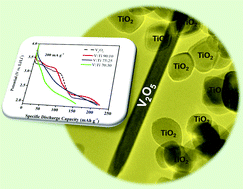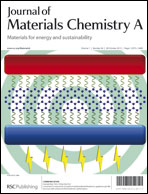Carbon nanocage supported synthesis of V2O5 nanorods and V2O5/TiO2 nanocomposites for Li-ion batteries†
Abstract
We present the facile synthesis of crystalline V2O5 nanorods and V2O5/TiO2 nanocomposites structures by a carbon nanocage (CNC)-assisted growth process, using vanadium triisopropoxide oxide and titanium isopropoxide precursors in air at 500 °C. The diameters of the resultant V2O5 nanorods ranged between ∼10 and 70 nm, while the crystalline V2O5/TiO2 nanocomposite structures adopted a unique morphology, due to both crystallisation and templating processes, with V2O5 adopting small-diameter nanowire and nanorod morphologies surrounded by sub-30 nm TiO2 nanoparticles. The V2O5 nanorods and V2O5/TiO2 nanocomposites were characterised by electron microscopy and X-ray diffraction techniques and subsequently reviewed as positive Li-ion electrodes. The phase-pure V2O5 nanorod structures exhibited appreciable Li+ storage properties over the potential range of 2.0–4.0 V vs. Li/Li+, displaying capacities of up to 288 mA h g−1 with appreciable cyclic behaviour at test rates of up to ∼1 C. The crystalline V2O5/TiO2 nanocomposite structures displayed similar Li+ storage properties, however, increasing molar fractions of TiO2 led to a decline in the overall capacity versus the single-phase V2O5 counterparts. Interestingly, the Li+ insertion behaviour of the V2O5/TiO2 nanocomposite displayed character more-typical of amorphous V2O5, which was ascribed to a structural buffering effect of the inactive TiO2 phase.


 Please wait while we load your content...
Please wait while we load your content...